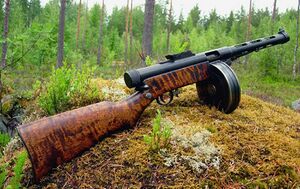Kpist/-31: Difference between revisions
(Created page with "{{Infobox weapon |name= Lahti Kpist/-31 | image= Kpist--31.jpg | image_size = 300 |caption= Lahti Kpist/-31 |origin= {{flagicon image|Esthar_and_balamb_35471.png|22px}} Est...") |
(→Users) |
||
| Line 59: | Line 59: | ||
{{flagicon image|Artesian Flag.jpg|22px}} [[Alteria]] <br/> | {{flagicon image|Artesian Flag.jpg|22px}} [[Alteria]] <br/> | ||
{{flagicon image|Dalmasca_and_nabradia_456735.png|22px}} [[Dalmasca and Nabradia]] <br/> | {{flagicon image|Dalmasca_and_nabradia_456735.png|22px}} [[Dalmasca and Nabradia]] <br/> | ||
{{flagicon image|Erebonian_Flag.jpg|22px}} [[Erebonian Empire]]: Acquired | {{flagicon image|Erebonian_Flag.jpg|22px}} [[Erebonian Empire]]: Acquired 500,000 from the Estharian Government in 1940 <br/> | ||
{{flagicon image|Esthar_and_balamb_35471.png|22px}} [[Esthar and Balamb]] <br/> | {{flagicon image|Esthar_and_balamb_35471.png|22px}} [[Esthar and Balamb]] <br/> | ||
{{flagicon image|Commonwealth of Jutland.jpg|22px}} [[Jutland-Gimli]]: Issued in 1937 after shortage of factory-producing weapons<br/> | {{flagicon image|Commonwealth of Jutland.jpg|22px}} [[Jutland-Gimli]]: Issued in 1937 after shortage of factory-producing weapons<br/> | ||
{{flagicon image|Great_Lucis_and_Accordo_-_Tristain.jpg|22px}} [[Great Lucis and Accordo|United Kingdom]]: Acquired 300,000 during the [[Middle East Campaign]]<br/> | {{flagicon image|Great_Lucis_and_Accordo_-_Tristain.jpg|22px}} [[Great Lucis and Accordo|United Kingdom]]: Acquired 300,000 during the [[Middle East Campaign]]<br/> | ||
Revision as of 06:55, 17 May 2020
| Lahti Kpist/-31 | |
|---|---|
 Lahti Kpist/-31 | |
| Type | Submachine gun |
| Place of origin | |
| Service history | |
| In service | 1931–Present |
| Used by | See Users |
| Wars | Estharian Civil War Second Europan War War of Lorican Aggression |
| Production history | |
| Designer | Urho Lahti |
| Designed | 1921 |
| Manufacturer | Prokkakoski |
| Produced | 1931–1967 |
| No. built | Approx. 2,500,000 |
| Variants | Kpist/-39 Kpist/-41 Kpist/-44 |
| Specifications | |
| Weight | 4.6 kg (10.14 lb) |
| Length | 870 mm (34.3 in) 925 mm (36.4 in) (SJR) 740 mm (29.1 in) (bunker version) |
| Barrel length | 314 mm (12.4 in) |
| Cartridge | 9×19mm Parabellum |
| Action | Straight Blowback |
| Rate of fire | 750–900 rounds/min |
| Muzzle velocity | 396 m/s (1,299 ft/s) |
| Effective firing range | 200m |
| Feed system | 20-, 36- or 50-round box, 40- or 71-round drum. |
| Sights | Front blade, rear notch |
The Lahti Kpist/-31 is a Balambian submachine gun used throughout the 20th Century. It was the main submachine gun of choice for the Estharian Army and the Balambian Defence Force during the Second Europan War.
Highly regarded as one of the most successful submachine gun during EWII, the soon developed 71-round drum magazine was later copied and adopted by the Imperials and Quenminese for the Type 40 SMG and the QMP-39. The accuracy of the Kpist/-31 was superior to the Type 40, thanks in part to a noticeably longer barrel, with the same rate of fire and the equally large magazine capacity.
The Kpist/-31 remains in service with a few regular armies, including the famed Balambian Forest Jaegers.
History
In 1921, Master Armourer Urho Lahti, a Finlandian native developed a prototype of a submachine gun called the M22. It was drastically changed several times until it was perfected in 1926.
In 1929, the East Europan Empire called for a more modern Submachine gun needed to replace its aging Berger MP 18. Master Armourer Urho Lahti, a Finlandian native was among those chosen to create such a weapon. Later that year, Lahti submitted his weapon and proved to be promising for the Imperials. However, the contract was won by East Europan Native Berthold Vollmer with his MP 30 design, which would eventually evolve into the Vollmer MP 35 and the Krimm MP 40. However, Balambian Minister of Defence, Kalle Mustonen approached Lahti to have his design be made in Balamb, in turn, he would be paid by the Balambian Government and granted government benefits. However, during that time, the Estharian Republican Government ruled both the regions of Esthar and Balamb. Communism was becoming rampant throughout the two regions. Lahti initially refused but agreed when the Balambian State seceded from the ruling government.
The first submachine guns were produced in Prokkakoski, Balamb where it was made in a small factory well-hidden from the eyes of the ruling government. When the Estharian Civil War began in 1932, the Balamb Government supported the Army Rebels under Generalissimo Ferdinand Franco and Lahti's factory became the leading source for weapons. When the rest of southern Balamb was taken in the autumn of 1932, Franco opened more factories and gave its ownerships to Lahti.
When the war ended; Lahti, along with Balambian Defence Minister Mustonen and Estharian Defence Minister Benito Pareja signed two important documents concerning the production of weapons and Lahti's company being the source of weapons used. The Submachine gun that found favour with Franco was given an increase in production, despite its expensive cost. Franco noted that it was the best machine gun of the war and had given the Nationalists victory.
Service
Users
![]() Alteria
Alteria
![]() Dalmasca and Nabradia
Dalmasca and Nabradia
![]() Erebonian Empire: Acquired 500,000 from the Estharian Government in 1940
Erebonian Empire: Acquired 500,000 from the Estharian Government in 1940
![]() Esthar and Balamb
Esthar and Balamb
![]() Jutland-Gimli: Issued in 1937 after shortage of factory-producing weapons
Jutland-Gimli: Issued in 1937 after shortage of factory-producing weapons
![]() United Kingdom: Acquired 300,000 during the Middle East Campaign
United Kingdom: Acquired 300,000 during the Middle East Campaign